How To Pack Clothes for Moving: 15 Hacks You Have To Try
Packing Tips and Hacks
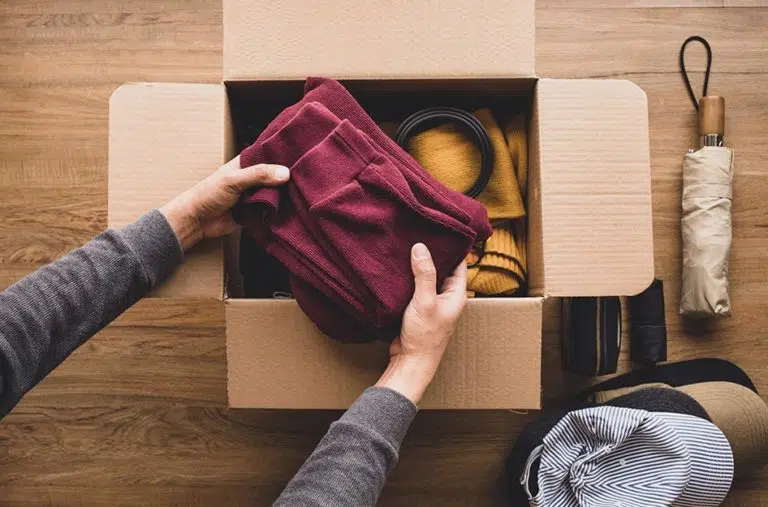
While this isn’t the worst way to pack, it can waste a lot of space and time (later) — not to mention leave you with a wrinkled and damaged wardrobe. Instead, make the entire moving process easier on yourself in the long run with these 15 tips on the best way to pack clothes for moving.
1. Purge Your Closets Before Packing Clothes for Moving.
While there are plenty of ways to roll, fold, and stack clothes, the one constant piece of advice is that you have to get started on the right foot, which means getting rid of clothing you no longer want or need. If you haven’t worn it in a year, there’s no reason to pack it. This may seem like obvious advice, but moving can be overwhelming, leaving little time to do extra work like sorting through closets and dressers. Taking the time on the front end, though, will save lots of unpacking time later.
So how do you declutter clothes before moving? The easiest suggestion is to go through your closets and donate or get rid of the items you haven’t worn in a year or longer. This could be because you or your family has outgrown them, they’re no longer in style, or they’re just not sparking joy anymore.
Need more help? Use this decluttering checklist, and if you have the time — and energy — consider hosting a garage sale before you move. It’s a great way to get rid of a lot of stuff quickly and make a little extra moving money.
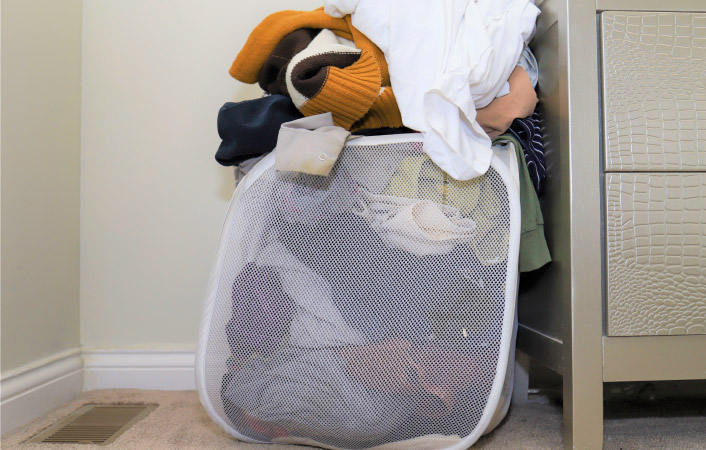
Try to launder as many clothes as possible before moving day.
2. Focus on Cleaning Clothes Before Packing Clothes.
Once your sell or donate pile is out the door, you’re left with the clothes that will be making the journey to your new home. If some of those clothes are dirty, wash them before packing. It can be tempting to take a laundry sack with you, but the last thing you’re going to feel like doing after unpacking is a load of laundry. Plus, stained, soiled clothes are only going to worsen after time spent in boxes and suitcases. Having everything fresh and clean before it’s packed makes unpacking much more pleasant.
3. Sort Clothes by Season Before Packing.
Many people ask, “When should I start packing clothes for moving?” The answer is that the best way to pack clothes for moving is to start early, so you can have plenty of time and don’t feel rushed. In fact, you can start as soon as you’ve put your house on the market or your name on a new lease (unless you’re a believer in jinxing things). It takes around 50 hours to pack a four-bedroom house, so keep that number in mind when factoring packing time into your moving timeline.
And chances are, you’re packing and moving during one season. That means you can pack up your out-of-season clothes without sacrificing your style. If it’s summer, go ahead and box up those winter items. If it’s winter, you won’t need those bathing suits any time soon. And if you’re experiencing wild weather mood swings, pack the items you know you won’t need for months.
You may think you’re going to unpack all of those boxes as soon as you get to your new home, but you’d be surprised how a few can escape for weeks — or even months — without being touched. Fun fact: Americans take an average of 182 days to finally unpack that last box.
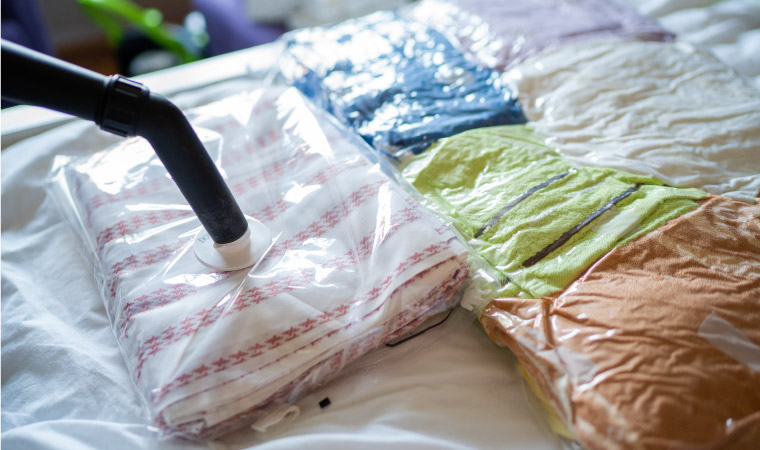
Vacuum bags condense bulkier items like sweaters, coats, blankets, and comforters.
4. Compress Bulkier Items To Save Space When Moving.
Unless you’re going to need all of those bulky winter jackets, ski bibs, and cold weather coveralls during your move, save space by putting those clothing items in compression bags, like these from Amazon. There are several vacuum storage bags on the market that are fairly inexpensive. Not only are the compression bags great for clothes, but they’re also perfect for pillows, comforters, and other large, soft home goods that can take up a significant amount of box space if left as-is.
5. Save Even More Space With the Army Roll.
Is it better to roll or fold clothes when packing a suitcase? While either method works when it comes to how to pack clothes for travel, we’re on Team Roll — more specifically, Team Army Roll. There are flat-fold devotees, and we’re not knocking that option, but folding can take up more space and create creases and wrinkles, especially if your clothes need to be stored for a longer period of time.We recommend the army roll because it maximizes space while minimizing wrinkles. And because a skill like this is best taught through visuals, here’s a video that explains how to pack clothes for moving using the rolling method:
Alternate idea: Not having any luck with the army roll? No worries. You can always use a more casual roll instead.
| Q: How do you pack clothes for a long time when moving? A: If you’re wondering how to pack clothes for moving and are preparing to store them for a significant amount of time (a month or longer), we suggest rolling the clothes rather than folding them before putting them in suitcases or boxes. This typically takes up less space and creates fewer creases and wrinkles. Do a tidy roll, though, or you could do more harm than good. The exception to the rule? Opt for folding instead of rolling if you’re using space-saving vacuum bags. The air compression on rolled clothing items can create a lumpy mess. |

Take your hanging items, put them directly in a wardrobe box, and — boom! — you’re done.
6. Use Wardrobe Boxes When Packing Hanging Clothing.
If you’re pressed for time and wondering the fastest and best way to move clothes that need to be on hangers, the answer is wardrobe boxes. This is also the best way to pack clothes for moving that are high-quality, valuable, etc., as it prevents them from being folded or rolled inside bags and boxes.
Take your hanging items, put them directly in a wardrobe box, and — boom! — you’re done. It’s a quick and easy method for packing hanging clothes.
However, if you have time, try not to rely too heavily on wardrobe boxes. They’re typically more expensive than regular packing boxes and take up a decent amount of space on a moving truck. If you’re already moving suitcases and dressers, you have free space to pack casual clothing like T-shirts, jeans, and undergarments. Use the wardrobe boxes for delicate items that need more protection or are prone to excessive wrinkling.
| Q: What is the best way to pack clothes for moving when you’re on a budget? A: Wondering how to pack clothes when moving and trying to cut costs? Use space you already have by putting clothing in suitcases, duffel bags, and even your dresser drawers (be sure to secure them with plastic wrap before transit). You’ll still need some boxes, though, so make sure you’re getting a good deal on supplies and not paying a premium for shipping. When you purchase moving materials on PODSboxes.com, you’ll not only find a variety of moving boxes and packing supplies to suit any relocation, but you’ll also receive free and fast delivery right to your door. |
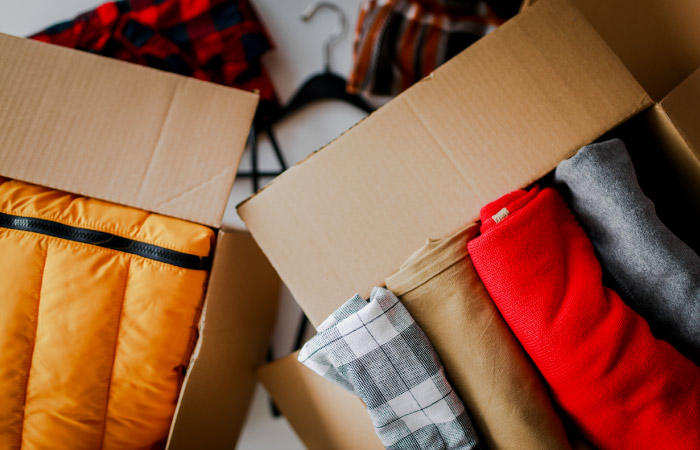
Using a large packing box? A good rule of thumb is to fill it with lighter items.
7. Pack Clothing Boxes Heavy to Light.
It’s tempting to load up a big box with lots of shirts and pants. But this isn’t the best way to pack clothes for moving because you’ll quickly weigh the box down. When packing clothes for moving, use small- to medium-sized boxes instead of large ones. To create a sturdy base, load the box with heavy items first — like jeans, sweaters, and jackets — then move to your lighter ones — like T-shirts, socks, and underwear.
8. Know Which Box To Use When Packing Clothes for Moving.
Should I put clothes in boxes or bags when moving? The short answer: You can use both. You’ve probably noticed that we’ve shared a few tips for how to pack clothes for moving that mention several packing and storage options, from regular moving boxes and wardrobe boxes to suitcases, dressers, vacuum bags, and more. How do you know which ones to use when?
Here’s a shortcut that lists your options and recommended usage:
Standard Cardboard Moving Boxes for Casual, Everyday Pieces
Is it OK to pack clothes in cardboard boxes? Packing clothes in boxes is fine, but you probably shouldn’t use them for every article in your wardrobe. Use cardboard boxes primarily when packing clothes that don’t require hanging and can withstand being folded or rolled. Also, if you’re considering how to pack clothes for moving cross country, keep in mind that there are more durable options than cardboard.
Wardrobe Boxes for Valuable Hanging Clothes
When you’re in a hurry or have high-value clothing items that need to stay on their hangers, wardrobe boxes are the best way to pack clothes for moving. They’re more expensive than standard cardboard boxes and do take up a lot of room, though, so use them sparingly.
Vacuum-Sealed Bags for Bulkier, Seasonal Clothing
If you look up tips on how to pack clothes when moving, vacuum-sealed bags will be high on all lists. Use these when you have bulky clothing items and the like that could benefit from compression. Think heavy jackets, sweaters, sweatshirts, ski pants, and even comforters and pillows.
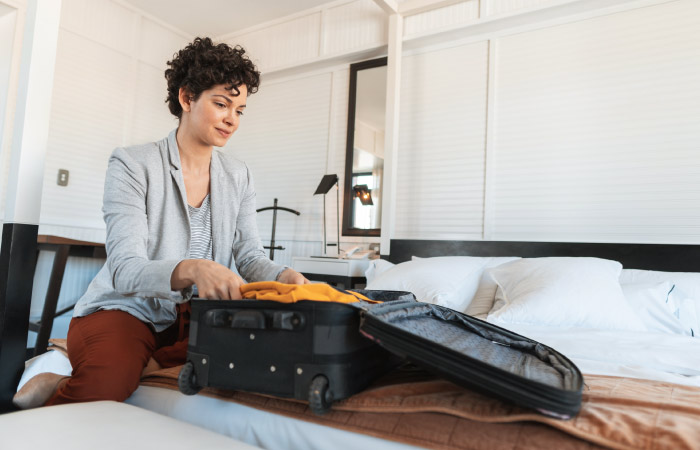
Suitcases and duffel bags are great for packing clothing you’ll need during and soon after your move.
Suitcases and Duffel Bags for Clothing You Need Immediately
Your suitcases and other pieces of luggage have to be moved, too. Put non-hanging clothing inside of them to maximize the storage space. This is a great option for the clothing you’ll need during and soon after your move.
Dresser Drawers for Streetwear
Can I leave clothes in drawers for movers? Yes, as long as you have the right type of dresser! Put more casual, non-hanging clothing inside dresser drawers, then wrap the dresser with plastic moving wrap when you’re done. If you have an overly heavy dresser, though, you may not want to load it full of clothing. It may make the piece too difficult to move. Light, assembled dressers won’t make sturdy moving pieces, either, as they may give way with the extra weight inside.
Garbage Bags for Less-Valuable Hanging Clothing
Many people recommend putting hanging clothing in trash bags because it’s cheap, convenient, and fast. Keeping the clothes on their hangers, you put the clothes in the bag upright and tie the top around the hangers. While this is a great pack hack, if you have clothing items of high value, this method may not give your wardrobe enough protection from the elements.
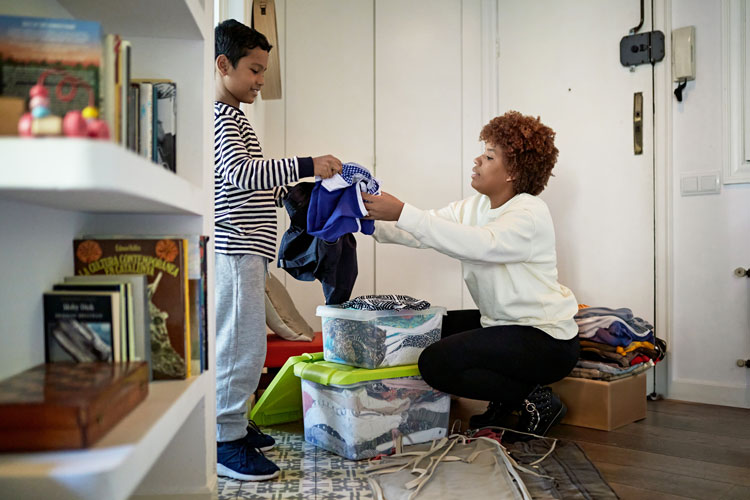
Plastic containers work well for shorter-distance moves, but they may crack under the pressure (literally) of a cross-country one.
Plastic Containers for Accessories, Shoes, and Smaller Clothing Items
Many people store their out-of-season clothing in plastic containers, so why can’t you just take those containers straight from the attic to the moving truck? While this isn’t a clear “don’t,” there’s a reason why moving boxes are made of cardboard instead of plastic. The containers, when stacked, put their entire weight on the container sitting below it, which can cause caving or cracking. Moving boxes, on the other hand, are made from double-walled corrugated cardboard, which works better for traveling and transporting. Use plastic boxes sparingly. A good way to reduce their need is to save them for smaller items that don’t fit as well inside your cardboard boxes.
| Q: Is it okay to pack clothes in cardboard boxes? A: Yes! While plastic containers are sturdier and reusable, cardboard boxes are more affordable, come in a variety of sizes, and keep the overall weight of your moving items down. Your clothes should be fine left inside a cardboard box for the duration of your move, but if you’re packing something extremely valuable, like a fur coat, you may want to take extra precautions when preparing the item and placing it securely inside the box. |
You may think you know the contents of each box, but you’ll be surprised at how quickly you forget once the neverending moving day to-do list competes for valuable memory space. Label your boxes with the room, but also add a quick note about the contents, so you know which ones need to be unpacked first. For bonus points, create a master inventory that lists boxes and their contents with a number or color system.
9. Bundle Before Packing Clothes.
Creating clothing bundles helps with packing and unpacking, too, because it keeps clothing organized and compact. Start your clothing bundle by laying a large item down, like a jacket. Next, put smaller pieces on top, filling the large piece until it’s filled. Then, wrap the large piece around the other smaller clothes to form a bundle. Load the bundles in a box with the heaviest ones at the bottom to keep things stable during loading and transit.
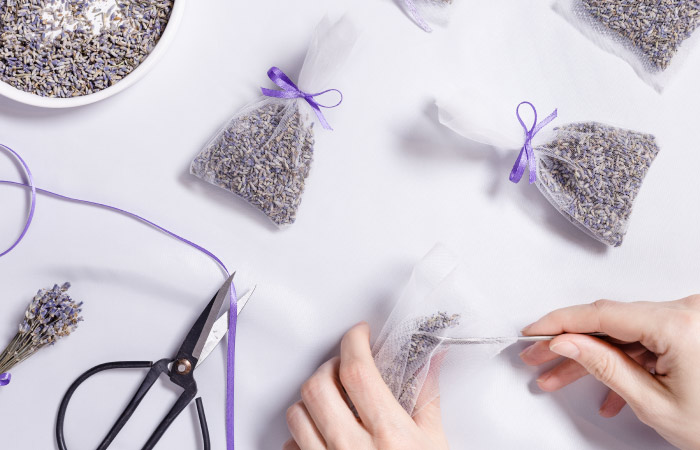
Keep smells at bay with lavender sachets, cedar chips, or dryer sheets.
10. Keep Clothes Smelling Fresh With Sachets or Sheets.
There’s lots of advice on how to pack clothes for moving, but there’s not as much information about how to keep clothes smelling fresh while moving. Even if your clothes are well-washed, they may still pick up some musty odors during the move — especially if you travel a long distance. Keep smells at bay with lavender sachets, cedar chips, or dryer sheets.
11. Stuff Your Shoes To Keep Them From Getting Squished.
Throwing shoes in boxes with your clothes will likely cause creasing and possibly even damage. This may be fine for tennis shoes and flats, but nicer pairs should be left in their shoe boxes or a similar style of container. If that’s not an option, or if that’s going to take up too much space, you can purchase shoe bags.
Be sure to stuff the insides of the shoes with tissue paper (or even socks!) so they’ll keep their shapes. Also, like your clothes, this is the perfect time to give those shoes a proper cleaning before they’re packed away. Don’t bring dirt into your new closet.
| Pro Tip: Looking for a cheaper option for boxing up your shoes? Wine boxes with dividers make great shoe caddies. You can probably find some free ones outside your local wine store. |

Have valuable jewelry? Keep it with you, if possible, during the move.
12. Pack Jewelry Separately.
It’s always a good idea to keep valuable items close to you during the move. Insurance only covers so much, and sometimes the unexpected happens. If there’s jewelry you can’t replace, put it in a small pouch, pair it with other important possessions, and keep it with you while you drive or fly to your destination.
If you have gloves, belts, or scarves that need some extra protection, wrap them in acid-free tissue paper before loading them into a box with similar items. This shields them from possible dust and moisture damage.
13. Have a Moving-Day Suitcase With Your “Need-Now” Clothes.
Once you get to your new home, the last thing you’ll want to do is sort through boxes to find your pajamas. Pack a duffel bag or suitcase with the essential items to get you through the first two or three days (not just the clothing). And don’t forget the coffee mugs!
14. Keep a Dirty Laundry Basket Handy.
Moving week is going to be busy, even under the best of circumstances! Despite the chaos, though, you and your family will still be dirtying clothes and requiring fresh ones. Have one designated laundry basket for the week leading up to your move so you can either run one last load or transport the basket to your new house. While bringing clean clothing into your new home is advisable, sometimes ongoing chores are unavoidable!
15. Don’t Forget To Pack the Hangers.
You’ve rolled your clothes like a pro and loaded your boxes, but now you’re left with a large mound of clothing hangers. What do you do with them? It’s tempting to toss them in a box of your own, but this is going to create a tangled mess. Instead, take a handful of hangers and tape or rubber band them together, then place them inside a box or garbage bag.
Want more packing tips? Visit the PODS Blog for additional packing hacks, packing advice straight from the pros, and more!
LB Gabriel is a freelance writer who lives with her husband, daughter, and Golden Retriever in Memphis, TN. A frequent PODS Blog contributor, she's a sucker for any tip she can find on downsizing, cutting clutter, or minimalist living. When she's not on a deadline, you can find her on a tennis court or golf course.









